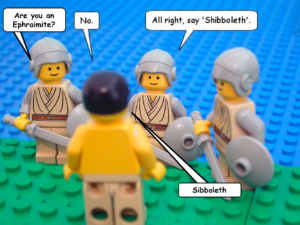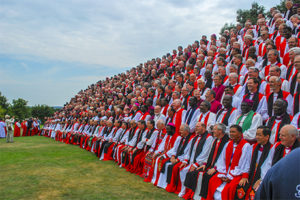 ‘An Englishman’s way of speaking absolutely classifies him;
‘An Englishman’s way of speaking absolutely classifies him;
The moment he talks, he makes some other Englishman despise him.’
So lamented Henry Higgins in the film My Fair Lady. Anyone who has referred to the main meal of the day as ‘supper’ in a northern working class town will know what he meant. And when I moved from Sussex to Bradford I scandalised a church committee by saying I was ‘knackered’. Among my southern friends that simply meant ‘tired out’, but in 1980s West Yorkshire it was a far less innocent term. Similarly, when we moved from the USA to the UK I had to learn a whole new vocabulary. I remember how surprised I was when a dignified and conservative elderly lady was referred to as ‘chesty’; while English people knew I was from America the minute I opened my mouth.
The urge to classify people, to decide whether or not they are ‘one of us’, is very human, but can be deadly. The Bible (Judges 12) recounts the tale of two Israelite tribes, Gilead and Ephraim, who fell out and fought each other. As the defeated Ephraimites fled for home, the Gileadites stopped the fugitives at a ford of the river Jordan. There was nothing visible to distinguish one tribe from another; they were all related. The men of Gilead had a test, however. They stopped each man trying to cross and asked him to pronounce the word ‘shibboleth’ (a Hebrew word meaning roughly ‘ear of corn’). The word was innocent enough, but it was pronounced differently by the two tribes. Those who pronounced it ‘sibboleth’ were killed on the spot.
We still use the word ‘shibboleth’ to denote words and customs which distinguish insiders from outsiders; acceptable people from unacceptable. In 1950s and 60s conservative evangelical America, it was assumed that people who smoked, drank alcohol, danced, or went to movies were not ‘saved’. English evangelicals of the time, on the other hand, were shocked to see the wives of Billy Graham’s team wore make-up; that was worldly. For decades, you could tell whether someone was your ‘sort’ of Christian by what they believed about predestination, or the Rapture, or transubstantiation. The debates have moved on now, but the principle is still the same. Divorce and remarriage, women’s ordination, same sex relationships…the issues change but there always is an issue. Or two, or three issues. When we sing,
We are not divided,
all one body we,
one in hope and doctrine,
one in charity
it too often seems a bitter mockery.
Some years ago I attended an interfaith conference at which scholar Ida Glaser gave a talk comparing a chapter from Galatians with a sura of the Koran. It was fascinating. Afterwards I chatted to a leader of the conservative group Reform, who was sitting next to me. Dr. Glaser was all wrong about Galatians, he thought. Her exposition had seemed sound enough to me, so I asked what he thought was wrong with it. ‘She keeps saying Galatians is about grace,’ he replied, ‘when really it’s all about keeping the Law.’ How had he reached that conclusion, I asked. ‘We have to have Law,’ he replied, ‘so we know who’s saved and who isn’t.’ This seemed to me a complete contradiction not only of the message of Galatians, but also of the Gospel itself. After all, Jesus himself warned that it isn’t possible in this world to distinguish between those who are God’s people and those who aren’t. Some may appear to follow God but in fact do not; others seem uninterested in Christianity but live in a way that pleases God. We are not the judges, and we shouldn’t try to be.
It’s a temptation very few of us can resist, however. I frequently engage in discussion and debate with Christians and others on social media. And quite often someone will ask me, when I have put my view of the topic in question, ‘Are you a Christian?’ The implication is that they have doubts. Occasionally one or more participants will tell me outright that I am not a Christian – particularly if they discover that I am an ordained woman, or don’t believe the Bible forbids faithful same sex relationships, or whatever else the issue under discussion is.
I grew up in greater Chicago, an Irish-settled area where Catholics and Protestants didn’t mix. My evangelical background, too, had taught me to be deeply suspicious of Roman Catholics, and to consider a number of their views heretical. Then I moved to Manchester, and found myself living next door to devout, and very hospitable, Catholics. Over a bottle of wine one night we discussed some of the differences between Anglican and Catholic worship and doctrine. I found to my surprise that often we used different words to mean the same thing; and sometimes we used the same words and meant something different. I got rid of a lot of my shibboleths that night. We became good friends, and I learned a lot from them and other Catholics. I came to treasure some aspects of Catholic spirituality in my own Christian life.
Coming from a fundamentalist background, that’s a pattern I’ve found over and over again; people I thought were ‘outside’ turn out to be ‘inside’. Many of them are closer to God than I am and know more of God’s love and acceptance. They are certainly more able to extend God’s love to others than I am.
Early Celtic Christians used to speak of the ‘two books’ of God: the book of the Bible and the book of nature. Looking at the book of nature, we see how much God loves variety. There is a vast diversity in almost every natural thing we can think of, from snowflakes to Homo sapiens. God’s creation rejoices in distinctiveness and difference; only human industrial processes turn out identical items.
There is no reason to think that God wants all his people to look the same, use the same words, or hold identical beliefs. In the words of an old hymn which has become increasingly meaningful to me over the years:
There’s a wideness in God’s mercy,
like the wideness of the sea;
There’s a kindness in his justice
Which is more than liberty.
But we make his love too narrow
By false limits of our own;
And we magnify his strictness
With a zeal he will not own.
For the love of God is broader
Than the scope of human mind,
And the heart of the Eternal
Is most wonderfully kind.
(Frederick William Faber)
This is a guest post contributed by Janet Fife








